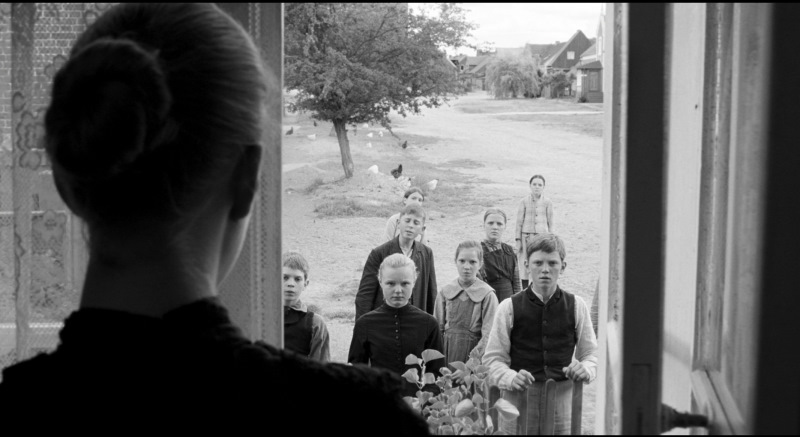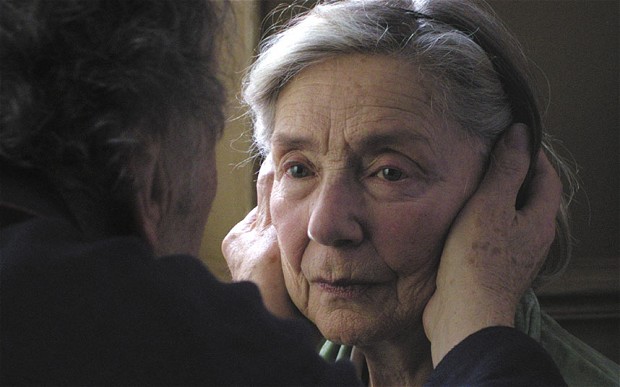However, the film where Haneke likely best shows the explosive power of evil stemming from apparently innocuous situations is the 2009 Palm d’Or winner, “The White Ribbon”.
“In The White Ribbon, the problem is fatherhood, not its absence: an icy rancor fostered at the heart of patriarchal households. In this, the film’s tacit social psychology comes more nearly into the orbit of explanations for Hitler centered on his own and his generation’s corporal punishment in childhood, with its vindictive authoritarian backlash. But if this is a large part of the film’s ethical charge, its narrative works to distribute the banality of such evil across a mesh of oblique culpability until its depravities are not just isolated but generalized, turned from psychological wounding toward political ferocity.” (GS, p. 42)
The film is set in a little German village where people live in an austerity, and where the white ribbon of purity is something of an educational guideline of pre-Nazi Germany.

Haneke wants to find the roots of Nazism in the “closed” moral education given to the German youth during the first half of the 20th century, but in the actions of the adults, we can find an extreme coldness that allows wicked feelings to arise.
“It is not just that the villagers’ actions undermine the sense of their words: they are not merely hypocrites. Nor are we witnessing a community of compulsive liars or an insane community of whose actions neither we nor they can make any sense. It is rather that the unusual manner in which members of this community act is so systematic, so resolutely cold and angry, that we wonder whether there is a further layer of meaning that our quick, outlandish hypotheses have failed to grasp: a layer that we will have somehow to grapple with if we are ever to understand them.” (JP, p. 9)
In “The White Ribbon”, there’s no community of liars, there’s only a huge amount of frustration that will one day explode. There’s no prophetic intent, but only a story of children growing into a strong fatherhood-based society where the repression of natural instincts is the base of education.
In this particular case there’s a convergence of psychology and politics, in particular, the psychological consequences of education. What if an overly-domineering form of education gains too much ground? Or better:
“The White Ribbon, too, takes the final, if only faintly tantalizing, twist of the whodunit plot, the question of second sight, and shifts it to a different level of premonition. The aberration isn’t unheimlich at all, but homebred – and then, in turn, endemic in its national ramifications. For on the historical as well as psychological plane, the story is indeed about one’s worst nightmares coming true.” (GS, p. 45)
In particular, the “evil” explosion is time-scattered. Haneke wants the spectator to focus on the origin of the wicked and not on the particular event, so these events are scattered in various moments of the film. But what we also need to notice is the hostile ambient takeover.
“The film is partially reconstructed on the basis of hearsay in Eichwald. Its scenes show us what was heard said in the village; yet, beyond that, the tone of these scenes – how the film is shot – show us how the hearsay was heard said. Its long, still gazes at the countryside imply the villagers’ isolation and desperation. Its protracted, crisp, and almost beautiful shots of day-to-day suffering, as well as its pervasive coldness, show the villagers’ malice. Its dark interior shots expose the villagers’ darkness.” (JP, 10-11)
However, if we need to question the “roots of evil”, we need to question ourselves. That’s why the psychological root of the society has a huge influence in this particular movie. Starting from the simple and natural education of children, we could have a totally different society. “The White Ribbon” shows us where evil dwells, and Haneke tried to give a visual dominion to this evil in the Eichwald village where the story is set.
And it seems that where evil dwells, we see the world in black and white. We sacrifice a real education toward the altar of an ideal purity without knowing the incredible consequences of banal events. In focusing on purity we lost the vision of real events in all their aspects, and we forget something in our educational methods.
“The point is not that some languages or schemes are too strange for us to understand. Rather, a being only counts as having a conceptual scheme, a mind, or a language, if they are interpreted and understood by us. The significance of this for The White Ribbon is that if we succeed in interpreting the ‘mind’ of the film, we are forced to confront that the disturbed community of Eichwald is not unintelligible. The film’s power is to lure us away from a familiar, and too often unreflective, anti-authoritarianism and anti-fascism, which produces facile judgments that ‘Nazis were evil people (unlike us).’ Instead, by placing us in an interpretative position of charity, the film insists that we work to uncover the underlying principles of the community before we evaluate it. It is only from this position that meaningful moral judgments about the dangers of authoritarianism and fascism can be made.” (JP, p. 12)
Haneke’s final purpose is probably unveiled in his last movie, “Amour”, where he faces the problematic relationship between love and illness. As in some of his other movies, the director pushes the psychological tension to the limit inside the narration, and as in the other three movies, he wants to create the perfect basis for the “evil-apex”, where the character has to explode.

The 2012 Palme d’Or winner is a constant reflection on the possibilities of love to face our physical degradation, and consequently, Haneke wants to show us the deep connection between physics and psyche. Curiously, we have no real limits to define what is banal and what is not, and in particular, in a situation like this, the apparently banal and normal physical decadence will let us know the limit of our capacity to love. And also, do we love a physical structure or a psychological idea of our lover?
The philosophical questions that could arise from this movie are so deep that we shouldn’t try to define them in this article, for us it’s enough to remember that illness, like sloth, education, and sex, takes their shapes from a apparent banality. But the disastrous effects that they could have on our psyche is a clear testimony that our mind is rooted in simplicity.
Works Cited:
GS : Garrett Stewart, Pre-War Trauma: Haneke’s The White Ribbon, Film Quarterly, Vol. 63, No. 4 (Summer 2010), pp. 40-47
JP : James Pearson, Interpreting Disturbed Minds: Donald Davidson and The White Ribbon, Film-Philosophy, Vol. 16 (2012), p. 1- 15
LC : Lisa Coulthard, Haptic Aurality: Listening to the Films of Michael Haneke, Film-Philosophy, Vol. 16 (2012), p. 16 – 29
Author Bio: Luca Badaloni is studying his master’s degree in Philosophy. He believes that cinema is a perfect instrument for philosophical ideas and actually society needs critical thinking in several ways. He loves to write script, direct short movies but mostly, he loves reading.